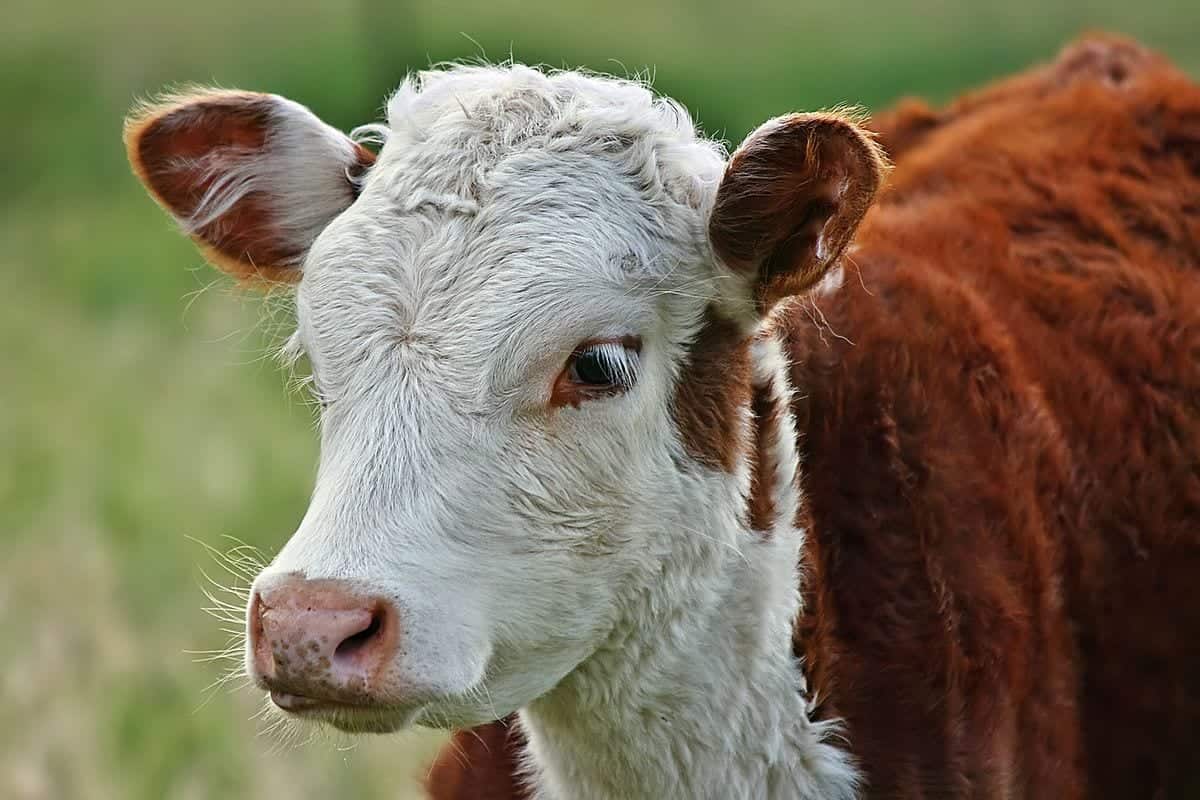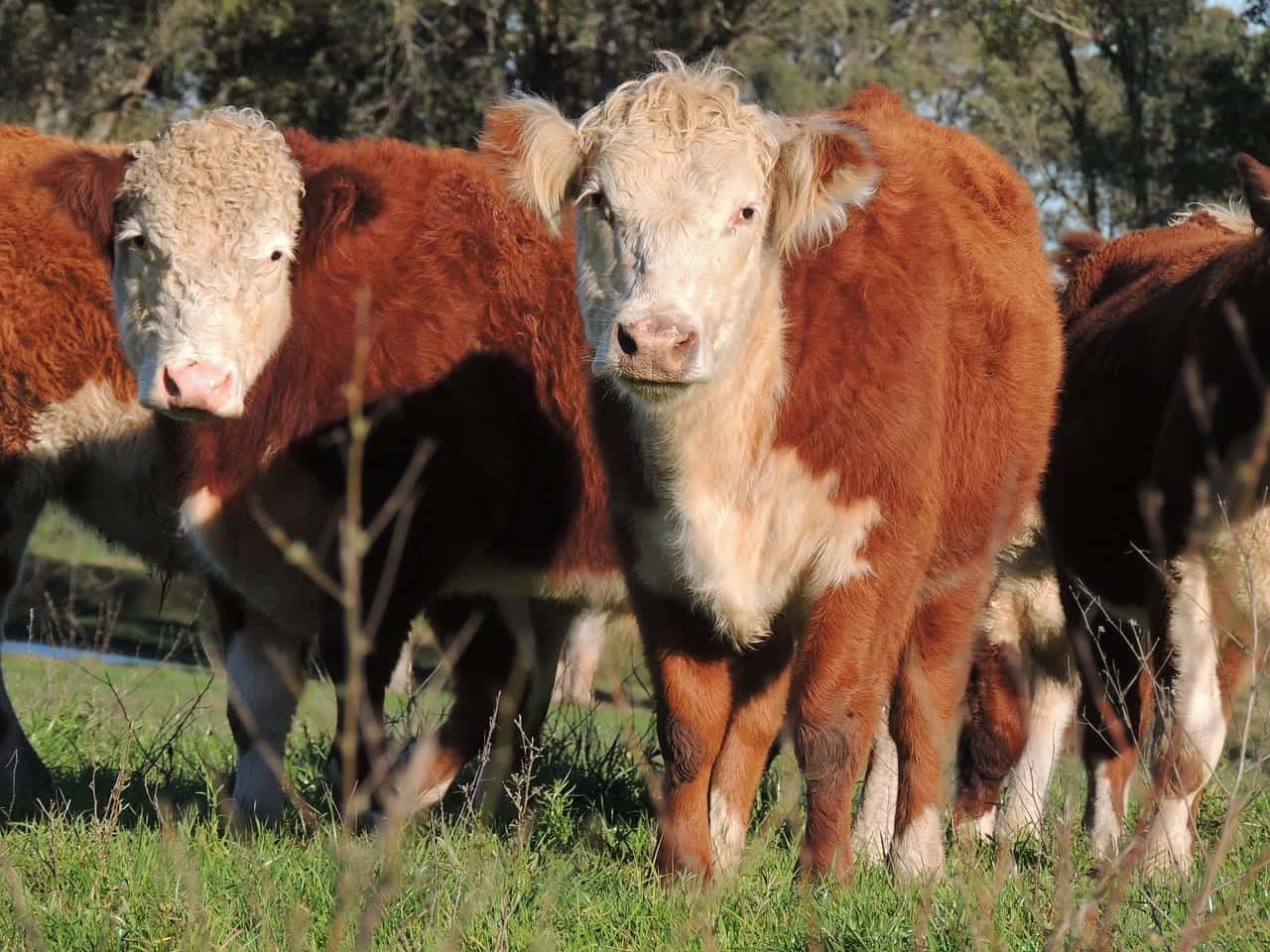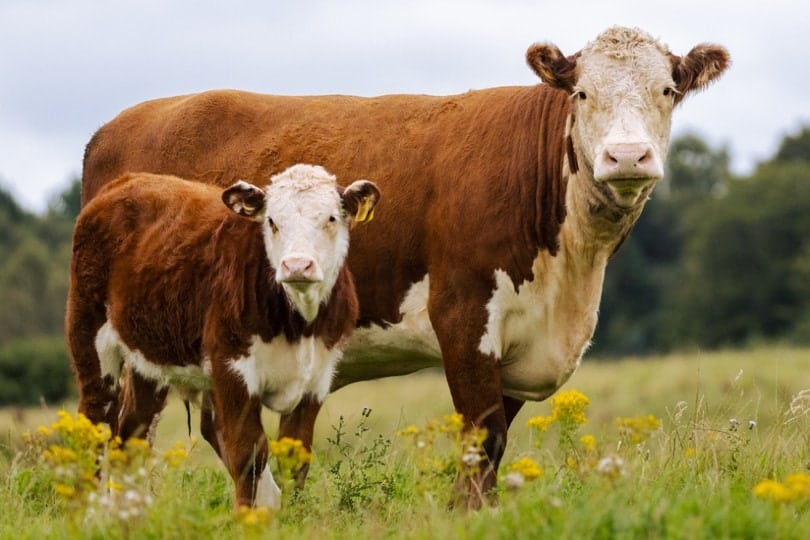The Hereford is a prolific breed of beef-producing cattle originating from England in the West Midlands. These cattle are adaptive, hardy, and tolerant which is convenient when successfully raising and farming them. Hereford cattle are a popular choice of cattle for farmers in the meat production industry. This is due to the wide availability of the cattle breed alongside their docile nature which makes them easy to handle.
Furthermore, this cattle breed has many interesting characteristics that may appeal to many cattle farmers, whether you are looking for cattle that can tolerate a wide range of temperatures or want to enjoy their undemanding and easy-going nature.

Quick Facts About Hereford Cattle

| Breed Name: | Hereford |
| Place of Origin: | England |
| Uses: | Beef production |
| Bull (Male) Size: | 59.8 inches |
| Cow (Female) Size: | 52 inches |
| Color: | Dark to yellowish-red |
| Lifespan: | 13-18 years |
| Climate Tolerance: | Arctic snows to moderate heat |
| Care Level: | Easy |
| Production: | Meat |
Hereford Cattle Origins
The direct origin of the Hereford cattle breed spans back as early as the fifth century in Herefordshire of West England. Not much information has been recorded about this cattle breed. But it is a popular belief that the Hereford cattle originated from wild aboriginal animals and was founded on the draught ox descendent from small red cattle of Roman Briton and the large Welsh breed which was once numerous along the border of Wales and England. The Hereford cattle breed was then imported into various countries between the early 1800s up until recent times, allowing for a large establishment of Hereford cattle in Australia, South Africa, the United States prairies, and South America.

Hereford Cattle Characteristics
The Hereford cattle breed is closely related to the miniature Hereford, a breed best known for their excellent maternal qualities and high-quality meat which makes them excellent stock for beef production industries.
- Docile nature makes these cattle easy to work with
- High-quality beef makes them profitable in the agricultural industry
- Climate tolerance as they can tolerate a wide range of climates that would be uncomfortable for other cattle breeds
- Adaptability to their environment
- Simple dietary requirements
- Overall health
- Early maturity
- Ability to produce offspring until 12 to 15 years of age
Uses
In the agricultural industry, Hereford cattle have many valuable uses. The most common and versatile reason most farmers raise this cattle breed is their high-quality meat. Hereford cattle are famous for their beef and it’s likely that you have encountered or even consumed Hereford cattle beef due to its wide distribution in many stores throughout the United States, Australia, and South Africa.
Aside from beef, this cattle breed is also used for milk production. Female Hereford cattle can reproduce until they reach around 15 years of age, which gives farmers plenty of time to utilize this breed’s milk.
They can perform well under tough conditions, such as the freezing arctic conditions to warm summers that occur in South Africa. This breed stands out for its economical uses, adaptive environmental ability, and beef and milk yield. Hereford cattle grow fast, which is convenient for both milk and beef production, and their calm temperament makes it easy for farmers to handle and care for this breed.

Appearance & Varieties
Aside from Hereford cattle’s excellent production qualities, this breed is attractive and built well. Hereford cows can weigh between 800 to 1,000 kg whereas bulls are much larger and weigh around 1,200 kg. The coat is short, shiny, and soft to the touch and ranges in color from dark blacks and browns to striking reddish yellows. It is also common to see patching in Hereford cattle, and the overall body coloration can consist of white and brown, or a dark yellow.
Hereford cattle have a muscular build and a medium size. The horns are curved down at the sides of their heads except for the polled Hereford, which is found in the United Kingdom and North America.
Related Read: 15 Fascinating and Fun Cow Facts You Never Knew
Population/Distribution/Habitat
Statistically, there are approximately 5 million Hereford cattle distributed worldwide. You will mainly find this cattle breed on farms. This breed is plentiful and found in over 50 nations. This tough cattle breed is located in Finland and endures the Arctic snows with ease, while still being able to adapt to the heat of Northern Transvaal where they graze on the tough grass and shrubs that grow in those regions. Hereford cattle were first exported from Britain in 1817 to Kentucky, where this cattle breed was widely distributed across the United States, Canada, and all the way to Mexico.
In today’s times, this cattle breed is popular in Australasia, Israel, Japan, Europe, and Scandinavia, even in Southern African countries such as Zambia, Zimbabwe, and South Africa. There are approximately 20 Hereford societies in member countries and several in non-member countries. The American Hereford Association is the official association in the United States, which is the second-largest society in the country, further proving how popular and useful these cattle are.

Are Hereford Cattle Good for Small-Scale Farming?
Hereford cattle are great for both small and large-scale farming. Beef cattle production is profitable even with small-scale farming and Hereford cattle form a large role in this style of farming. Raising Hereford cattle requires minimal skill, money, and land, which makes this breed ideal for both new and experienced farmers looking for a popular cattle breed that is tolerant to a wide range of climates, easy to handle, and profitable to manage.
Hereford cattle are good for farmers who have a genuine interest in cattle and want to experience the ease of keeping cattle for beef or milk production without having to worry about the cattle struggling to adapt to the weather, feeding schedule, and handling by the workers and farmers. Overall, Hereford cattle have many qualities that make them the popular cattle breed that they are.
Featured Image Credit: Scott Allan, Shutterstock
